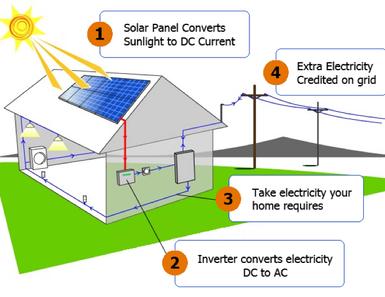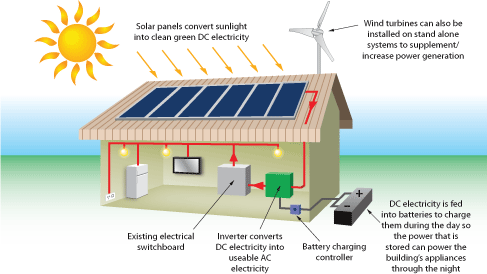About photovoltaic (PV) solar panels
A solar panel (also called a solar module, photovoltaic module or photovoltaic panel) is a packaged, connected assembly of
photovoltaic cells. The solar panel can be used as a component of a larger photovoltaic system to generate and supply
electricity in commercial and residential applications. Each panel is rated by its DC output power under standard test
conditions, and typically ranges from 100 to 320 watts. The efficiency of a panel determines the area of a panel given
the same rated output - an 8% efficient 230 watt panel will have twice the area of a 16% efficient 230 watt panel.
Because a single solar panel can produce only a limited amount of power, most installations contain multiple panels.
A photovoltaic system typically includes an array of solar panels, an inverter, and sometimes a battery and or solar
tracker and interconnection wiring.
Grid-connected Photovoltaic System

Photovoltaic power systems are generally classified according to their functional and operational requirements,
their component configurations, and how the equipment is connected to other power sources and electrical loads.
The two principal classifications are grid-connected or utility-interactive systems and stand-alone systems.
Photovoltaic systems can be designed to provide DC and/or AC power service, can operate interconnected with or independent
of the utility grid, and can be connected with other energy sources and energy storage systems.
Grid-connected or utility-interactive PV systems are designed to operate in parallel with and interconnected with
the electric utility grid. The primary component in grid-connected PV systems is the inverter, or power conditioning
unit (PCU). The PCU converts the DC power produced by the PV array into AC power consistent with the voltage and power
quality requirements of the utility grid, and automatically stops supplying power to the grid when the utility grid is
not energized. A bi-directional interface is made between the PV system AC output circuits and the electric utility network,
typically at an on-site distribution panel or service entrance. This allows the AC power produced by the PV system to either
supply on-site electrical loads, or to back-feed the grid when the PV system output is greater than the on-site load demand.
At night and during other periods when the electrical loads are greater than the PV system output, the balance of power required
by the loads is received from the electric utility This safety feature is required in all grid-connected PV systems, and ensures
that the PV system will not continue to operate and feed back into the utility grid when the grid is down for service or repair.
Stand-Alone Photovoltaic Systems

Stand-alone PV systems are designed to operate independent of the electric utility grid, and are generally designed
and sized to supply certain DC and/or AC electrical loads. These types of systems may be powered by a PV array only,
or may use wind, an engine-generator or utility power as an auxiliary power source in what is called a PV-hybrid system.
The simplest type of stand-alone PV system is a direct-coupled system, where the DC output of a PV module or array is
directly connected to a DC load. Since there is no electrical energy storage (batteries) in direct-coupled systems,
the load only operates during sunlight hours, making these designs suitable for common applications such as ventilation fans,
water pumps, and small circulation pumps for solar thermal water heating systems. Matching the impedance of the electrical load
to the maximum power output of the PV array is a critical part of designing well-performing direct-coupled system. For certain
loads such as positive-displacement water pumps, a type of electronic DC-DC converter, called a maximum power point tracker (MPPT)
used between the array and load to help better utilize the available array maximum power output.
In many stand-alone PV systems, batteries are used for energy storage. The diagram shows a typical stand-alone
PV system powering DC and AC loads.
Hybrid Solar PV System

If you were thinking that there is nothing stopping you from having both types of system installed at the same
time you would be absolutely right. A Hybrid system gives you all the benefits of both systems with the added benefits
from protection from power cuts and outages (from either solar or mains), coupled with the ability to live independently
of fossil fuels whilst supplying others with clean, green energy.
A Hybrid Solar PV System would utilise a connection to the grid enabling power to be exported and also use batteries to
protect against power cuts and store power for use locally.
Please note that as with all grid connected PV systems, in hybrid systems we need to protect against islanding, this
is where the PV system would continue to generate and export power to the grid even if the mains power was unavailable.
For safety the PV system will disconnect itself from the grid if mains power becomes unavailable, hybrid systems will continue
to supply power to the property in the event of a power cut.